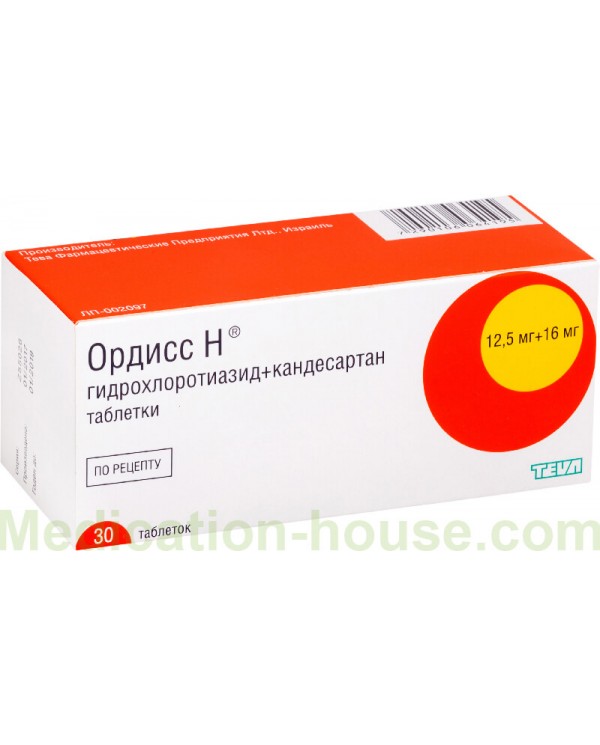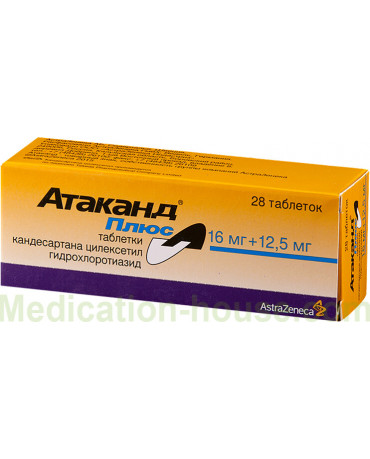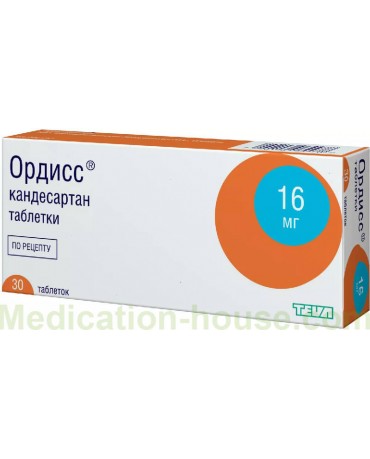Ordiss H instruction
You can buy Ordiss H here
Ordiss H is a combined antihypertensive agent.
Release form and composition
Dosage form of the drug - tablets: capsule-shaped, biconvex, scored on both sides, pale pink (12.5 + 16 mg and 25 + 32 mg) or from white to almost white (12.5 + 32 mg); “C” engraved on one side of the tablet on opposite sides of the risk | "16" (12.5 + 16 mg) or "C" | "32" (12.5 + 32 mg and 25 + 32 mg), on the other side (for 25 + 32 mg) - "H" | "25" (5 pcs. In a blister, in a pack of 6 blisters; 10 pcs. In a blister, in a pack of 3 blisters. Each pack also contains instructions for the use of Ordiss H).
1 tablet contains:
active substances: hydrochlorothiazide - 12.5 / 12.5 / 25 mg + candesartan cilexetil –16/32/32 mg, respectively;
additional components: calcium carmellose, pregelatinized starch, poloxamer 188, povidone-K30, lactose monohydrate, microcrystalline cellulose, magnesium stearate; additionally for a dosage of 12.5 + 16 mg and 25 + 32 mg - dye iron oxide red (E172).
Pharmacodynamics
Ordiss H is a combined drug, the action of which is due to the properties of the active ingredients.
Candesartan is a selective antagonist of angiotensin receptors type 1 (AT1-receptors) of angiotensin II - the main hormone of the renin-angiotensin-aldosterone system (RAAS), which is assigned a major role in the pathogenesis of diseases of the cardiovascular system (CVS), including arterial hypertension. (AH). The effects of angiotensin II are mediated by its binding to AT1 receptors. Candesartan does not inhibit angiotensin-converting enzyme (ACE), which is responsible for converting angiotensin I to angiotensin II and deforming bradykinin. Due to the inhibition of AT1 receptors, the level of renin, angiotensin I and II increases in a dose-dependent manner, and the content of aldosterone in the blood decreases. Candesartan is less likely to lead to the development of cough than ACE inhibitors (ACE inhibitors) and does not block ion channels that regulate the function of the CVS.
Hydrochlorothiazide is a thiazide-like diuretic that suppresses sodium reabsorption in the distal renal tubules and increases the excretion of chloride, sodium and water ions. Reduces blood pressure (BP), the volume of extracellular fluid and blood plasma, the intensity of blood movement by the heart. With prolonged therapy, the hypotensive effect occurs as a result of the expansion of arterioles. Reduces the risk of cardiovascular damage.
Ordiss H has a cumulative hypotensive activity, provides an effective and long-term decrease in blood pressure without increasing the heart rate (HR). At the first application, orthostatic hypotension is not noted, after the completion of the course, AH does not increase. The hypotensive effect as a result of a single dose of pills develops over 2 hours. When using the drug 1 time / day, blood pressure decreases gently within 24 hours, the maximum effect differs slightly from the average.
According to research data, the development of adverse events, especially cough, with Ordiss H therapy was noted less often than with a combination of ACE inhibitors with hydrochlorothiazide.
Pharmacokinetics
Candesartan
Candesartan cilexetil, after absorption from the gastrointestinal tract (GIT) by ether hydrolysis, is rapidly converted to candesartan and strongly binds to AT1 receptors, and then destroys them. Absolute bioavailability as a result of oral administration is about 40%, relative - 34% (when comparing tablets with oral solution). Food intake has no significant effect on the area under the concentration-time pharmacokinetic curve (AUC).
After receiving Ordiss H, the maximum concentration (Cmax) of candesartan is observed after 3-4 hours. Its content increases linearly with increasing dose within the recommended limits, the connection with plasma proteins is more than 99%, the volume of distribution in plasma (Vd) is 0.1 l / kg.
Candesartan is metabolized in the liver to an insignificant extent, cumulation is not observed.
It is excreted mainly unchanged through the intestines and by the kidneys [by glomerular filtration (CF) and tubular secretion]. After oral administration of radioactively labeled candesartan, 26 and 7% are eliminated by the kidneys, and 56 and 10% of the received dose are excreted in the feces in the form of candesartan and an inactive derivative, respectively. The total clearance of the substance is 0.37 ml / min / kg, the renal clearance is 0.19 ml / min / kg. The half-life (T1 / 2) is approximately 9 hours.
Hydrochlorothiazide
Hydrochlorothiazide is rapidly absorbed from the gastrointestinal tract, bioavailability is about 70%, but may be lower in patients with severe edema and heart failure. Simultaneous intake with food increases absorption by about 15%. Visible Vd ~ 0.8 l / kg, it binds to proteins on average by 60%.
Not metabolized. Almost completely excreted in the form of the main substance through renal elimination, by CF and tubular secretion. T1 / 2 ~ 9 h, does not change when used in combination with candesartan. Within 48 hours, approximately 70% of the dose is excreted.
Indications for use
Ordiss H is recommended for the treatment of hypertension in cases where combination therapy is indicated.
Contraindications
Absolute:
refractory hypercalcemia, hypokalemia;
severe renal / hepatic impairment;
condition after kidney transplantation;
cholestasis;
lactase deficiency, lactose intolerance, glucose-galactose malabsorption syndrome;
gout;
primary hyperaldosteronism;
simultaneous use of Ordiss H with aliskiren or aliskiren-containing drugs against the background of diabetes mellitus and / or impaired renal function (CF rate <60 ml / min per 1.73 m2);
pregnancy and lactation;
age under 18;
hypersensitivity to active and auxiliary components of antihypertensive drugs and other sulfonamide derivatives.
Relative (it is recommended to use Ordiss H with caution):
renal / hepatic impairment;
stenosis of an artery of a single kidney, bilateral stenosis of the renal arteries (the content of urea and creatinine in the blood increases);
reduced volume of circulating blood (BCC) (the likelihood of symptomatic arterial hypotension increases);
acute myopia, angle-closure glaucoma;
systemic lupus erythematosus;
cerebrovascular lesions;
diabetes;
hemodynamically significant stenosis of the aortic and / or mitral valve, hypertrophic obstructive cardiomyopathy, ischemic heart disease, severe chronic heart failure (CHF);
combined use with the following drugs: lithium preparations, antiarrhythmics, cardiac glycosides, cholestyramine, tubocurarine, colestipol, non-steroidal anti-inflammatory drugs (NSAIDs), anticholinergic drugs, β-blockers, glucocorticosteroids (GCS), cytotoxins, benzylanthinateenicillins, ethoxin adrenocorticotropic hormone (ACTH), iodine-containing X-ray contrast agents, amphotericin, potassium-sparing diuretics, carbenoxolone, salicylic acid derivatives, epinephrine, general anesthetics, and other antihypertensive drugs.
Ordiss H, instructions for use: method and dosage
Ordiss H tablets are taken orally, regardless of the time of the meal, once / day, 1 pc.
Before switching from monotherapy with hydrochlorothiazide to Ordiss H, titration of the dose of candesartan is recommended. If necessary, the patient is transferred from candesartan in monotherapy to a combined antihypertensive drug.
A stable hypotensive effect is achieved during the first 4 weeks after the start of the course and is maintained with long-term treatment.
If there is a threat of arterial hypotension, for example, in persons with reduced BCC, titration of the candesartan dose is recommended, starting with a dose of 4 mg.
Side effects
Negative side reactions from systems and organs that have been observed when taking candesartan:
hematopoietic system: extremely rarely - neutropenia, leukopenia, agranulocytosis;
central nervous system (CNS): often - dizziness; very rarely - headache;
respiratory organs: extremely rare - cough;
skin and subcutaneous tissues: extremely rarely - urticaria, itching, rashes, angioedema;
digestive system: extremely rarely - nausea, abnormal liver function, increased activity of hepatic transaminases, hepatitis;
musculoskeletal system and connective tissue: extremely rare - arthralgia, myalgia, back pain;
metabolism and nutrition: extremely rare - hyponatremia, hyperkalemia;
kidneys and urinary tract: extremely rare - renal failure.
Negative side reactions from systems and organs that have been observed when taking hydrochlorothiazide:
immune system: rarely - anaphylactic reaction;
CNS: often - vertigo, dizziness; rarely - anxiety, sleep disturbances, depression, paresthesia;
hematopoietic system: rarely - leukopenia, thrombocytopenia, agranulocytosis, neutropenia, aplastic anemia, hemolytic anemia, decreased hemoglobin, inhibition of bone marrow function;
CVS: infrequently - postural hypotension; rarely - vasculitis, arrhythmia;
organ of vision: rarely - decreased vision clarity, acute angle-closure glaucoma and acute myopia (symptoms include pain in the eyes or a sudden decrease in vision, if they appear, it is necessary to urgently stop taking Ordiss H and consult a doctor);
digestive system: infrequently - loss of appetite, irritation of the gastric mucosa, anorexia, constipation, diarrhea; rarely - intrahepatic cholestatic jaundice, pancreatitis;
kidneys and urinary tract: often - glucosuria; rarely - interstitial nephritis, impaired renal function;
respiratory organs: rarely - pneumonitis, respiratory distress syndrome, pulmonary edema;
musculoskeletal system and connective tissue: rarely - muscle spasm;
skin and subcutaneous tissues: infrequently - urticaria, skin rash, photosensitivity reaction; rarely - recurrence of cutaneous erythematosis, erythematous-like reactions, toxic epidermal necrolysis;
metabolism and nutrition: often - hypokalemia, hyponatremia, hyperglycemia, hyperuricemia;
others: often - weakness, an increase in the plasma concentration of cholesterol, triglycerides in the blood; rarely - fever, increased levels of creatinine, urea in the blood.
Overdose
The main symptoms of an overdose of Ordiss H may presumably include a significant decrease in blood pressure and dizziness.
There have been reports of cases of overdose of candesartan at a dose of up to 672 mg, which did not cause serious consequences and ended in recovery.
The manifestations of an overdose of hydrochlorothiazide can be a decrease in the BCC, dizziness, imbalance of fluid and electrolytes, a decrease in blood pressure, dryness of the oral mucosa, ventricular arrhythmia, tachycardia, muscle cramps, loss of consciousness.
Treatment with a pronounced decrease in blood pressure is symptomatic, ensuring control of the state of the body. It is recommended to lay the patient on his back and raise his legs. If necessary, increase the BCC, including by intravenous infusion of 0.9% sodium chloride solution. Perhaps the appointment of sympathomimetics. The use of hemodialysis to remove Ordiss H is ineffective.
Special instructions
Persons with severe CHF, kidney damage, including renal artery stenosis, and other diseases in which vascular tone and renal function depend on the activity of the RAAS, have a particular sensitivity to drugs that affect this system. The use of such drugs in patients from this group can provoke severe arterial hypotension, azotemia, oliguria, and in rare cases, acute renal failure. The development of similar effects is not excluded with the appointment of angiotensin II receptor antagonists (ARA II).
In the presence of ischemic cardiopathy, cerebrovascular lesions of ischemic origin, a sharp decrease in blood pressure with the use of any antihypertensive drugs can aggravate the risk of stroke or myocardial infarction.
Hypercalcemia detected against the background of receiving Ordiss H may be a symptom of latent hyperparathyroidism. The therapeutic course must be suspended until the results of the study of the function of the parathyroid glands are obtained.
Influence on the ability to drive vehicles and complex mechanisms
If the use of Ordiss H causes adverse effects on the part of the central nervous system, patients who drive vehicles or work with complex equipment need to be careful.
Application during pregnancy and lactation
Ordiss H tablets are contraindicated for use during pregnancy and lactation.
If pregnancy is diagnosed against the background of drug therapy, it must be immediately canceled.
Childhood use
Patients under 18 years of age are not prescribed Ordiss H.
With impaired renal function
Renal failure of severe degree, with creatinine clearance (CC) <30 ml / min per 1.73 m2, is an absolute contraindication for the appointment of Ordiss H.
With stenosis of an artery of a single kidney or bilateral stenosis of the renal arteries, the drug is used with caution. Dose titration is recommended for patients with mild / moderate renal impairment (CC 30–80 ml / min per 1.73 m2).
During the period of therapy with Ordiss H, patients with renal insufficiency should regularly monitor the plasma content of uric acid, creatinine and potassium.
For violations of liver function
Severe liver failure and / or cholestasis are absolute contraindications for the use of Ordiss H.
For mild to moderate hepatic impairment, dose titration is recommended.
In patients with progressive liver disease or liver dysfunction, thiazide diuretics should be used with great caution, since even small fluctuations in the electrolyte composition and fluid volume can lead to hepatic coma.
Use in the elderly
Elderly people do not need dose adjustment of Ordiss H.
Drug interactions
glibenclamide, warfarin, enalapril, digoxin, nifedipine, oral contraceptives (ethinyl estradiol / levonorgestrel): do not reveal clinically significant interactions with Ordiss H;
ARA II and NSAIDs, including cyclooxygenase-2 inhibitors, non-selective NSAIDs (acetylsalicylic acid> 3 g / day): weaken the hypotensive effect of candesartan;
lithium preparations: the serum lithium content rises reversibly and toxic reactions develop; monitoring of the level of lithium in the blood is recommended;
other antihypertensive drugs: the hypotensive effect increases;
potassium preparations, potassium-sparing diuretics, table salt substitutes containing potassium and other agents that increase serum potassium levels (heparin): hyperkalemia may occur;
NSAIDs: weaken the diuretic, natriuretic and hypotensive activity of hydrochlorothiazide;
ARA II, ACE inhibitors or aliskiren inhibitors (renin inhibitor): double blockade of the RAAS is associated with an exacerbation of the threat of fainting, arterial hypotension, hyperkalemia, renal functional impairment (including acute renal failure) when compared with candesartan / hydrochlorothiazide monotherapy; requires regular monitoring of blood pressure, kidney activity and electrolyte levels;
ACE inhibitors and type 4 dipeptidyl peptidase inhibitors (vildagliptin): aggravate the risk of developing Quincke's edema;
diazoxide, β-blockers: their hyperglycemic effect increases;
diuretics, amphotericin, laxatives, penicillin G sodium salt, carbenoxolone, salicylic acid derivatives (drugs that cause loss of potassium and hypokalemia): enhance the effect of hydrochlorothiazide, leading to potassium deficiency; the risk of hypokalemia increases with cirrhosis of the liver, increased urine output, heart / renal failure;
non-depolarizing muscle relaxants (tubocurarine): their effect is enhanced;
cholestyramine, colestipol: weaken the absorption of hydrochlorothiazide;
vitamin D or calcium-containing food supplements: calcium excretion decreases and its concentration in plasma increases; it is important to ensure that calcium levels are monitored and the dose adjusted if necessary;
anticholinergics (biperiden, atropine): the bioavailability of thiazide diuretics increases due to weakening of gastrointestinal tract motility;
cytostatics (cyclophosphamide, methotrexate): the elimination of these substances slows down and the myelodepressant effect increases;
cardiac glycosides, antiarrhythmic drugs: the likelihood of cardiotoxic side effects due to hypokalemia and hypomagnesemia associated with diuretics increases;
amantadine: the threat of its unwanted effects is aggravated;
barbiturates, ethanol, general anesthetics: the incidence of orthostatic arterial hypotension increases while taking Ordiss H;
GCS or ACTH: the likelihood of hypokalemia increases;
vasoconstrictor amines (epinephrine): their effect decreases;
iodinated filler (in high doses): in combination with hydrochlorothiazide increases the risk of acute renal failure;
antidiabetic agents (including insulin): glucose tolerance decreases and a change in their dose may be required.
Terms and conditions of storage
Store at a temperature not exceeding 25 ° C. Keep out of the reach of children.
Shelf life is 2 years.
Reviews
Rare reviews about Ordiss H are mostly positive. Patients note that it effectively stabilizes blood pressure, providing a mild hypotensive effect.
However, sometimes they indicate the development of side effects, including pronounced ones, due to which, in some cases, hypertensive patients had to abandon Ordiss H.
Terms of sell
You don't need a prescription to buy Ordiss H.



